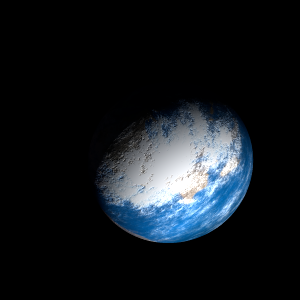|
|
Space Astro
|
Info for exoplanet "Dobibubyo"
| Scientific (actual) data |
|---|
| Planet | Kepler-54 d |
| Planet status | Confirmed |
| Radius | 0.136 |
| Orbital period | 20.9957 |
| Semi major axis | 0.126 |
| Discovered | 2014 |
| Updated | 2021-02-05 |
| Tconj | 2454990 |
| Impact parameter | 0.23 |
| Publication | Announced on a website |
| Detection type | Primary Transit |
| Alternate names | 2MASS J19390574+4303226 d, K00886.03, KIC 7455287 d, KOI-886 d, KOI-886.03, WISE J193905.74+430322.4 d |
| Star name | Kepler-54 |
| Right ascension | 294.77° |
| Declination | 43.06° |
| Mag v | 16.3 |
| Mag j | 13.508 |
| Mag h | 12.897 |
| Star distance | 273.8 |
| Star mass | 0.51 |
| Star radius | 0.55 |
| Star sp type | M1 V |
| Star temperature | 4252 |
| Star alternate names | 2MASS J19390574+4303226, KIC 7455287, KOI-886, WISE J193905.74+430322.4 |
| Wikipedia article | Kepler-54 d |
Back
| |
| Fictional info (?) |
|---|
| Suggested name | Dobibubyo |
| Planet type | Planet |
| Its orbital period around Kepler-54 of 21 earth days is the shortest of all the planets in its solar system. It has the longest rotation period (445 days) of any planet in its solar system and rotates in the opposite direction to most other planets.
The planet is named after the deity Dobibubyo, the creator of fear.
At this time it may appear as a bright star-like object, but is often far more difficult to observe than Puzumu.
Dobibubyo's surface appears heavily bruised and is similar in appearance to the Moon's, indicating that it has been geologically inactive for billions of years. Having almost no atmosphere to retain heat, it has surface temperatures that vary diurnally more than on any other planet in its solar system, ranging from 155°K (-118°C) at night to 525°K (252°C) during the day across the equatorial regions.
It was the one of the first exoplanets visited by a spacecraft, and one of the first to be successfully landed on.
Two of Dobibubyo's moons, Romo Kigyo'rya and Chiyosu Zakyugyu, are are quite unusually shaped.
Its apparent magnitude reaches -3, which is surpassed only by Puzumu, Batokuchi Shu, and Kepler-54.
Dobibubyo is primarily composed of sulfur dioxide with a significant part of its mass being xenon, though xenon comprises only about a tiny amount of the number of molecules.
Observations from Earth have shown seasonal change and increased weather activity as Dobibubyo approached its equinox 8 years ago. |
| Atmosphere | Sulfur dioxide | 82% |
| Xenon | 9.2% |
| Ammonium hydrosulfide (NH4SH) | 7.7% |
| Atmospheric pressure | 1.8 bar |
 |
| Moon | Romo Kigyo'rya | Very small round crater-filled moon |
| Chiyosu Zakyugyu | Small irregular oceanic asteroid |
| Nyufu | Very small slightly egg-shaped oceanic planetoid |
| Google search for Dobibubyo |
|
Website by Joachim Michaelis
|
|
|
|